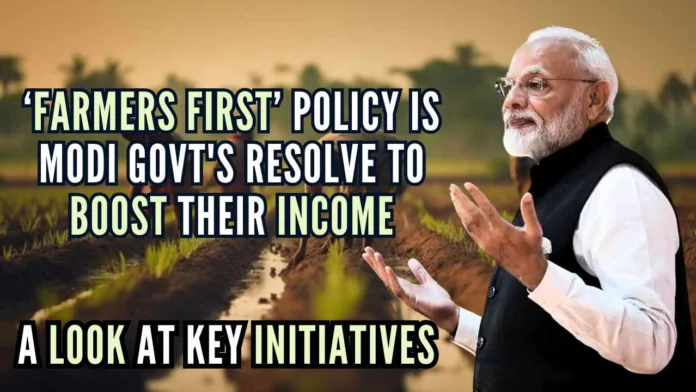
PM Modi shares a booklet detailing steps taken for farmer livelihoods and well-being
With the farmers launching agitation on Delhi borders for the second time in less than three years, the Opposition has launched a scathing attack against the Narendra Modi government, accusing it of not just depriving the farmers of their rightful earnings, but also ‘suppressing’ their demonstration for genuine demands.
The barrage of allegations and rebuttals continues to fly, but the Modi government has maintained that its commitment to the welfare and upliftment of the farming community remains uncompromised, as it has been consistently working towards bringing a defining change in their lives.
Prime Minister Narendra Modi’s personal X handle on Saturday shared a comprehensive booklet, detailing the wide array of steps taken for the livelihood and well-being of the farmers.
Titled ‘Putting Farmers First’, the booklet takes a deep dive into the Centre’s policies and decodes the steps taken to improve the living standards of farmers.
Notably, PM Modi has been a staunch votary of the farming community’s contributions to the nation’s growth and has advocated doubling the income of the farmers ever since he came to power in 2024.
Even when he was the Gujarat Chief Minister, farmers’ welfare had topped his priorities.
“’Vibrant Gujarat’, the government’s flagship investor summit, garnered big headlines. It is a two-day event held once every two years. However, Krishi Mahotsav was held every year under Narendra Modi’s tenure. Under the month-long programme, all levels of the state government were mobilized to work with the farmers,” the booklet said.
Here is an account of the Centre’s funds allocation and mobilization of government machinery for the farmers’ welfare:
Bigger Budget, Better utilization
- The budget for agriculture has increased five times from Rs 1.37 lakh crore during 2007-14 to Rs 7.27 lakh crore during 2014-25.
- The PM-KISAN scheme was launched, under which 11 crore farmers got financial assistance of Rs 6,000 per year.
- For the first time, an MSP increase was announced. The minimum support price of all 22 crops was set at a minimum of 50 percent more than the cost.
- For the 2020 and 2021 Rabi seasons, Rs 2.37 lakh crore was paid to the farmers during the pandemic in the form of MSP for crops like wheat, paddy, oilseeds, and pulses.
Farming and Soil Health
- Organic farming has received an unprecedented boost under the Modi government. Flagship initiatives like Paramparagat Krishi Vikas Yojana were launched, while steps were also taken to improve soil health.
- The Soil Health Card Scheme first launched during Narendra Modi’s government in Gujarat, was introduced nationally in 2014-15. Soil health cards provide the farmers with the nutrient status of their soil and its composition. Hundreds of labs across the country test soil and provide farmers with detailed information, which helps them make informed decisions.
- In 2015-16, the Paramparagat Krishi Vikas Yojana was launched to promote organic farming. Over Rs 70 crore has been released to the farmers. Organic farming covers an area of 64 lakh hectares in the country under various programmes.
- Zero budget farming was also introduced to promote farming sans the use of chemical fertilisers. This would make farming more viable for the small farmers and help them get rid of debt cycle.
- Under the Bharatiya Prakritik Krishi Padhati programme, an area of 4.09 lakh hectares has been covered and a total fund of Rs 49.81 crore has been released in eight states.
Quality Seeds for Farming
- Since 2014, a comprehensive total of 1,971 crop varieties resilient to climate challenges have been created and introduced. Among these, 429 varieties are designed to withstand abiotic stresses, while 1,542 are tailored to resist biotic stresses.
- Since 2014, a cumulative total of 369 high-yielding varieties across 14 pulse crops have been introduced in India.
- In 2016, 150 pulses seed hubs and 12 centers were established to bolster breeder seed production, resulting in the production and distribution of 7.09 lakh quintal of quality seed and 21,713 quintals of breeder seed from 2016-17 to 2022-23.
- A total of 1,587.74 lakh quintals of quality seed were produced, involving 6.39 lakh villages.
- The availability of certified/quality seed has increased from 158.19 lakh quintal in 2014- 15 to 514.26 lakh quintals in 2022-23.
- The number of farmers benefiting from the Seed Village Programme rose from 21.29 lakh in 2015-16 to 45.51 lakh in 2022-23.
Extending Credit Facility to Farmers
- Kisan Credit Cards were introduced to enhance the government’s outreach to farmers.
- Allocation of Rs.1.25 lakh crore was made with a targeted agricultural credit of Rs 20 lakh crore for animal husbandry, dairy, and fisheries in FY 2022-23.
- Institutional credit to farmers increased from Rs.7.3 lakh crore in 2013-14 to Rs.21.55 lakh crore in 2022-23, saving more farmers from the clutches of private moneylenders.
- Rs.2 lakh crore credit boost to 2.5 crore farmers at reduced interest rates via Kisan Credit Cards (KCC).
- Increasing the reach of formal credit, 2 crore new farmers were covered with an additional credit flow of Rs.2.5 lakh crore.
Impetus to Agricultural Infrastructure
- Pradhan Mantri Krishi Sinchayee Yojana (PMKSY) was launched in 2015, under which micro-irrigation and water conservation practices were introduced.
- Between 2014-15 and 2021-22, around 7.64 lakh water harvesting structures were built or revitalized.
- Cold storage capacity in the nation has risen from 318.23 lakh metric tonne in 2014 to 394.17 lakh metric tonne presently.
- In a bid to improve market access and reduce post-harvest losses, PM Modi launched the Kisan Rail and Krishi Udaan schemes.
- To tackle the shortage of food grain storage, the government approved the ‘World’s Largest Grain Storage Plan in Cooperative Sector’ on May 31, 2023. Over 2,000 PACS (Primary Agricultural Credit Societies) have been selected for the creation of storage capacity as part of the Pilot Project.
Crop Insurance
- In the last seven years of its implementation, the PM Fasal Bima Yojana has enrolled over 55 crore farmer applications.
- Farmers have paid a premium of nearly Rs.30,000 crore while they have received a claim of over Rs.1.5 lakh crore. This shows that for every Rs.100 that the farmers have paid as a premium, they have received Rs.521 as claims.
- Around 85 percent of the farmers enrolled under the scheme are small and marginal farmers.
Minimum Support Price
- The government announced multiple MSP hikes based on the formula that the farmers will get at least 1.5 times the cost of production. This was a promise made and delivered.
- Between 2014 and 2023 (10 years), crores of farmers have received nearly Rs.18 lakh crore as MSP for paddy and wheat crops. This is 2.5 times more than the preceding 10 years before 2014.
[With Inputs from IANS]
For all the latest updates, download PGurus App.
- Myanmar authorities seize 100 Kg methamphetamine, 13 kg of ketamine in southern region - April 28, 2024
- Centre permits export of 99,150 tonnes of onion to 6 countries - April 28, 2024
- Delhi Congress chief resigns, cites party’s alliance with AAP - April 28, 2024










